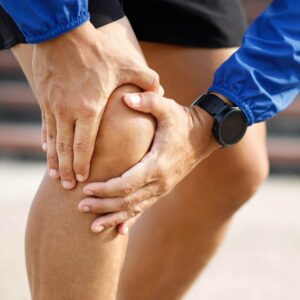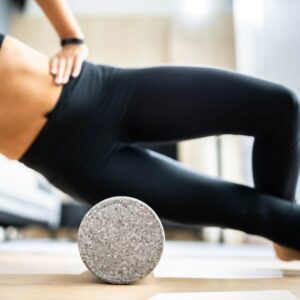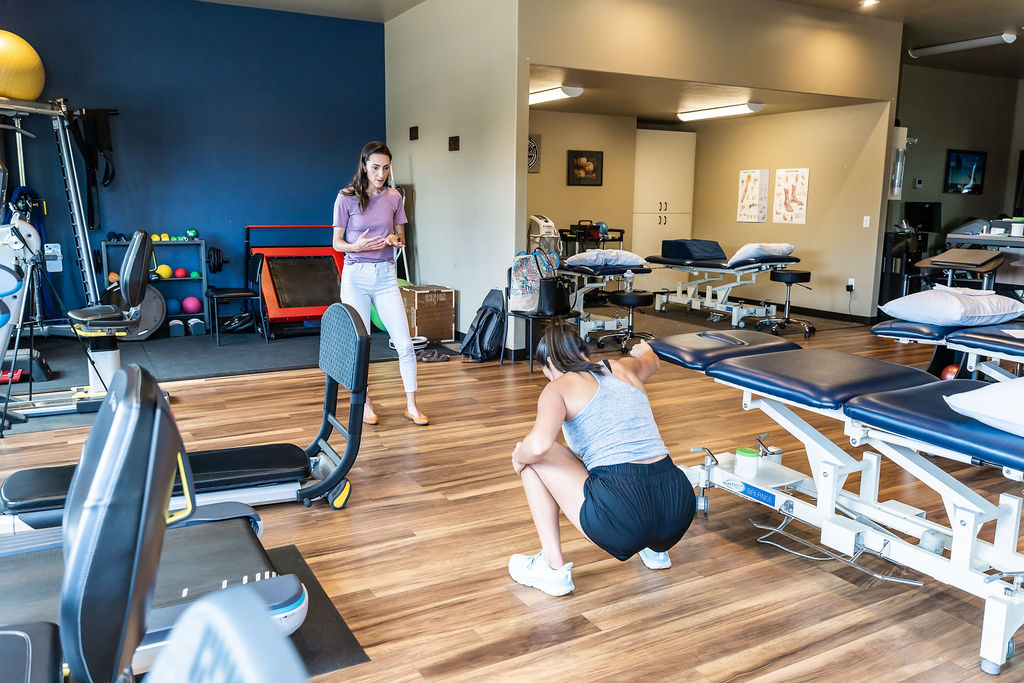The Ultimate Guide to Runner’s Knee Treatment for Runners
Have you ever felt a dull ache or sharp discomfort in the front of your knee during or after a run? That familiar twinge is often referred to as runner’s knee—and it’s one of the most frustrating injuries for runners because it can seem to appear out of nowhere and linger longer than expected. The good news? With the right approach, you can address runner’s knee effectively and prevent it from holding you back.
In this post, we’ll cover the causes of runner’s knee, explain how poor movement mechanics contribute to it, and share a research-backed treatment plan designed specifically for runners.
Looking for Runner’s Knee Treatment in Boise?
What Is Runner’s Knee?

Runner’s knee, or patellofemoral pain syndrome (PFPS), is characterized by pain around the front of the knee, usually under or around the kneecap. It’s often felt during activities like running, squatting, or walking downhill. Unlike an acute injury, runner’s knee develops over time due to repeated stress on the patellofemoral joint.
This condition is more than just “overuse” in the traditional sense—it’s often a sign that your muscles and joints aren’t absorbing impact as efficiently as they should.
Imagine a runner named Alex, who loves tackling the Boise foothills but has recently started experiencing a dull ache in the front of his knee during his long runs. Instead of stopping completely, he decided to push through—only to find the pain intensifying after each session. Alex’s experience is a classic example of how small imbalances, like weak glutes or overstriding, can contribute to runner’s knee. By addressing these underlying factors with targeted exercises and slight form tweaks, Alex could get back to enjoying his runs pain-free.
Common Causes of Runner’s Knee in Runners
While the term “overuse” is commonly blamed for runner’s knee, the truth is more nuanced. Most running-related injuries, including PFPS, occur when the load placed on the knee exceeds what the tissues can handle. Here are some contributing factors:
- Weakness in the Hips and Glutes: Your hips and glutes play a major role in stabilizing your knees. If they aren’t strong enough, the knee can be forced into compensatory movement patterns.
- Pro Tip: Single-leg strengthening exercises can improve hip stability, reducing unwanted inward knee movement during strides.
- Poor Single-Leg Control: Running is essentially a series of single-leg jumps. If your balance and strength on one leg aren’t solid, excessive stress can build up around the knee.
- Cadence and Overstriding: Runners who take longer strides often land with more force, which can increase the load on the knees. A lower cadence (fewer steps per minute) often correlates with overstriding.
- Rich Willy Insight: Increasing your cadence by 5-10% can lower the impact forces on your knees by up to 20%.
- Training Errors: Sudden increases in mileage, pace, or hill work without proper adaptation can overload the knee.
- Example: If you add hill repeats into your weekly runs without building up your quad and glute strength, the extra downhill force can aggravate the patellofemoral joint.
What Not to Do: Busting Common Myths
There’s a lot of outdated advice floating around about how to treat runner’s knee. Here are some common myths and what you should do instead:
- Myth 1: Foam rolling your IT band will fix everything.
- Truth: The IT band is a thick band of connective tissue that doesn’t “release” with foam rolling. Instead, focus on strengthening the surrounding muscles (such as the gluteus medius) to support proper knee alignment.

- Myth 2: Just stop running until it goes away.
- Truth: Total rest can lead to muscle deconditioning and doesn’t address the root issue. Instead, modify your running and incorporate strengthening exercises.
- Myth 3: Patellofemoral pain is purely a knee issue.
- Truth: Runner’s knee is often the result of poor mechanics upstream (hips, core) or downstream (ankles, feet). A holistic approach works best.
Biomechanics: Why Runner’s Knee Happens
Experts like Rich Willy and Chris Johnson emphasize that patellofemoral pain is rarely just a knee issue—it’s often the result of poor mechanics in the entire lower body. When the glutes, hips, and quads aren’t doing their job, the knee ends up bearing more load than it should.
- Biomechanical Insight: When you land mid-stride, your knee absorbs 3-5 times your body weight. Weak hips or poor core control can cause the knee to collapse inward, increasing pressure on the patellofemoral joint.
Research shows that increasing your running cadence by 5-10% can significantly reduce the impact forces on your knee. By taking shorter, quicker steps, you reduce the amount of time your foot spends on the ground and limit how much your knee has to absorb with each stride.
Treatment Plan: Exercises to Strengthen and Stabilize
A strong, resilient knee requires a combination of hip strengthening, single-leg control, and core stability. Here’s a breakdown of key exercises designed to address the root causes of runner’s knee:
Best Exercises to Prevent Runner’s Knee
1. Squats (Back or Front)
- How to Do It:
Stand with your feet about shoulder-width apart. Keep your chest up, lower your hips as if you’re sitting back in a chair, and drive through your heels to return to standing. For back squats, the barbell rests across your upper back. For front squats, hold the bar across the front of your shoulders with elbows up. - Why It Works:
Squats are one of the best ways to build quad strength, which is often the weak link in runner’s knee. They also engage the glutes and core. - Progression Tip:
Start with bodyweight or a light bar/dumbbell. As you gain confidence and proper form, gradually increase weight. If possible, work with a coach or trainer to ensure you’re lifting safely.
2. Split Squats / Bulgarian Split Squats
- How to Do It:
In a split squat, start in a lunge position with one foot forward and the other behind. Lower your back knee toward the floor, then push back up. For a Bulgarian split squat, elevate your back foot on a bench or step. Keep most of your weight in your front leg. - Why It Works:
These moves build single-leg strength and stability in the quads and glutes—key for supporting the knee during running. - Progression Tip:
Once you master bodyweight split squats, add dumbbells or a barbell. Keep your torso upright to avoid unnecessary knee strain, and remember that “heavy” is relative to your ability—incremental increases over time help prevent injury.
3. Lunges
- How to Do It:
Step forward, backward, or walk forward in a controlled stride. Lower your back knee toward the ground, keeping your front knee stacked over your ankle. Push through your front foot to return to the start. - Why It Works:
Lunges target the quads, glutes, and hip stabilizers—all crucial for preventing excessive knee load. - Progression Tip:
Explore forward, reverse, or walking lunges to challenge balance and coordination. Adding weights (dumbbells/kettlebells) ramps up the difficulty. If you feel knee discomfort, shorten your stride until you build strength.
4. Step-Ups
- How to Do It:
Stand in front of a sturdy box or step. Place one foot on the step, press through your heel, and lift your body up onto the step. Slowly lower back down under control. - Why It Works:
Step-ups isolate the quads on the working leg and help improve single-leg control, which is vital for efficient and pain-free running form. - Progression Tip:
Start with a lower box/step height. Add dumbbells or hold a barbell on your back to increase the load once you feel confident.
5. Calf Raises
- How to Do It:
Stand with your feet hip-width apart and rise onto the balls of your feet. Lower back down slowly. For an extra challenge, do them on one leg or use a step so your heels can drop below toe level. - Why It Works:
Calves assist with shock absorption and push-off during running. Strengthening them reduces the stress transferred up to your knees. - Progression Tip:
Begin with bodyweight calf raises, then add a weighted backpack or hold dumbbells. Perform them in a controlled manner to get the most out of each rep.
A Note on “Lifting Heavy”
When it comes to preventing runner’s knee, lifting heavier weights can be a game-changer because it boosts your muscles’ capacity to handle high-impact forces. However, it’s critical to increase weights gradually. Focus on mastering technique with lighter loads first—good form helps you avoid injuries and ensures the right muscles are doing the work. If you’re new to heavier lifting, consider consulting a qualified trainer or physical therapist for guidance.
Remember, any strength program should complement your running schedule. Balancing your training volume, intensity, and recovery will help you stay strong, avoid setbacks, and keep runner’s knee at bay.
How to Modify Your Running
Instead of stopping completely, implement a walk-run strategy:
- Start with a 4:1 ratio (4 minutes of running, 1 minute of walking).
- Gradually increase running time as symptoms improve.
Additional Tips from Running Experts:
- Increase cadence: Aim for 170-180 steps per minute to reduce knee impact.
- Avoid downhill running: This places extra load on the knee.
- Warm up properly: Dynamic stretches and activation exercises can prepare your knees for impact.
How Physical Therapy Can Help
Trying to figure out the right exercises and running modifications on your own can feel overwhelming, especially when you’re unsure how to progress safely. This is where working with a physical therapist (PT) who specializes in running injuries can make a significant difference.

- Personalized Assessment: A PT will assess your strength, flexibility, and movement patterns to identify the root cause of your runner’s knee. Instead of guessing which exercises to do, you’ll have a tailored program designed to address your specific weaknesses.
- Proper Exercise Progression: One of the biggest mistakes runners make is either doing too much too soon or staying at the same intensity for too long. A PT can guide you through appropriate progressions, ensuring you’re building strength without flaring up your symptoms.
- Gait Analysis: Specialists like those at Fit & Function can analyze your running form and recommend small but impactful tweaks, such as adjusting your cadence or stride length, to reduce knee stress.
- Active Recovery Guidance: Instead of complete rest, a PT can create a walk-run or modified training plan that allows you to maintain fitness while recovering.
- Injury Prevention for the Long-Term: PTs help you build resilience so that runner’s knee doesn’t become a recurring issue. With regular check-ins and strength maintenance plans, you can feel confident that your knees will stay strong for future training cycles.
Local Insight: Boise Running Routes and Considerations
If you’re a Boise runner, consider adjusting your routes while recovering. The Boise Greenbelt offers flat, paved paths that reduce downhill strain, making it an excellent option for maintaining mileage without excess stress on your knees. Julia Davis Park and Ann Morrison Park also provide gentle, looped paths ideal for recovery runs or walk-run intervals.
For runners seeking softer surfaces, the trails around Camel’s Back Park offer dirt paths that can be gentler on joints compared to concrete but still require caution due to elevation changes. Additionally, you can check out community groups in Boise, like local running clubs, for recommended low-impact routes and pacing support.
Conclusion
Runner’s knee can feel like a frustrating setback, but it doesn’t have to be the end of your running journey. By strengthening the right muscles with exercises like single-leg step-downs and banded lateral walks, adjusting your running form, and following a structured recovery plan, you can get back to pain-free running. Working with a physical therapist ensures you’re progressing exercises appropriately and avoiding common pitfalls, such as doing too much too soon or neglecting key areas like glute strength and core control.
Whether you’re tackling the Boise foothills or training for your next marathon, these strategies can keep you moving strong and resilient. If you’re dealing with persistent knee pain or want expert guidance, our team at Fit & Function Therapy Solutions offers personalized assessments and programs to help you build resilience and prevent future injuries.
Check out our Running Analysis Service or our Strength Training Programs for Runners to take the next step toward your goals.
Credit: This post draws on insights from Rich Willy, Chris Johnson, and other leading running specialists known for their evidence-based approach to patellofemoral pain syndrome.

